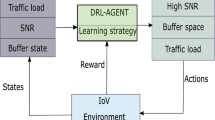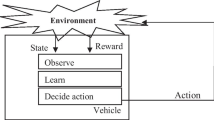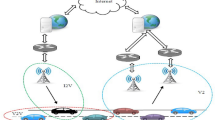Abstract
The high number of connected nodes in Internet of Vehicles (IoVs) drives to high data exchange between nodes, which increases the network overhead. Moreover, the recurrent change in vehicle mobility in Internet of Vehicles (IoVs) drives to frequent changes in network topology which in turn causes frequent link disconnections. Therefore, the most addressed issues in IoVs are to manage the high quantity of packets sent by the huge number of vehicles connected with IoT devices, to reduce communication delays and guarantee the longest communication stability. Clustering techniques have been utilized to reduce network overhead in IoVs networks. Classical clustering algorithms have been proposed to enhance network performances. However, IoVs environment is characterized by the high dynamicity of nodes, therefore, the optimization methods already proposed cannot perfectly deal with the characteristics of IoVs. Reinforcement learning (RL) is a machine learning algorithm, where the agent learns from its environment and tries to enhance its policies to obtain the best reward. In this paper, we propose to use deep reinforcement learning (DRL) to select the best cluster heads based on node’s degree, node’s buffer size, and signal strength. In the proposed work, the vehicle can perfectly select the cluster heads by choosing the best state-action values taking in consideration the high dynamicity of the network.







Similar content being viewed by others
REFERENCES
Gasmi, R. and Aliouat, M., Vehicular ad hoc networks versus Internet of vehicles-A comparative view, 2019 Int. Conf. on Networking and Advanced Systems (ICNAS), Annaba, Algeria, 2019, IEEE, 2019, pp. 1–6. https://doi.org/10.1109/icnas.2019.8807870
Gasmi, R., Aliouat, M., and Seba, H., A stable link based zone routing protocol (sl-zrp) for internet of vehicles environment, Wireless Personal Commun., 2020, vol. 112, pp. 1045–1060. https://doi.org/10.1007/s11277-020-07090-y
Sharif, A., Li, J., Saleem, M., Manogran, G., Kadry, S., Basit, A., and Khan, M.A., A dynamic clustering technique based on deep reinforcement learning for Internet of vehicles, J. Intell. Manuf., 2020, vol. 32, pp. 757–768. https://doi.org/10.1007/s10845-020-01722-7
Padakandla, S., A survey of reinforcement learning algorithms for dynamically varying environments, ACM Comput. Surv., 2021, vol. 54, no. 6, pp. 1–25. https://doi.org/10.1145/3459991
Gasmi, R. and Aliouat, M., A weight based clustering algorithm for Internet of vehicles, Autom. Control Comput. Sci., 2020, vol. 54, pp. 493–500. https://doi.org/10.3103/S0146411620060036
Gasmi, R., Aliouat, M., and Seba, H., Geographical information based clustering algorithm for Internet of vehicles, Machine Learning for Networking, Renault, É., Boumerdassi, S., and Mühlethaler, P., Eds., Lecture Notes in Computer Science, vol. 12629, Cham: Springer, 2020, pp. 107–121. https://doi.org/10.1007/978-3-030-70866-5_7
Bellaouar, S., Guerroumi, M., and Moussaoui, S., QoS based clustering for vehicular networks in smart cities, Dependability in Sensor, Cloud, and Big Data Systems and Applications. DependSys 2019, Wang, G., Bhuiyan, M.Z.A., De Capitani di Vimercati, S., and Ren, Y., Eds., Communications in Computer and Information Science, vol. 1123, Singapore: Springer, 2019, pp. 67–79. https://doi.org/10.1007/978-981-15-1304-6_6
Zhang, D., Gong, C., Zhang, T., Zhang, J., and Piao, M., A new algorithm of clustering AODV based on edge computing strategy in IOV, Wireless Networks, 2021, vol. 27, pp. 2891–2908. https://doi.org/10.1007/s11276-021-02624-z
Mukhtaruzzaman, M. and Atiquzzaman, M., Clustering in vehicular ad hoc network: Algorithms and challenges, Comput. Electr. Eng., 2020, vol. 88, p. 106851. https://doi.org/10.1016/j.compeleceng.2020.106851
Riley, G.F. and Henderson, T.R., The ns-3 network simulator, Modeling and Tools for Network Simulation, Wehrle, K., Güneş, M., and Gross, J., Eds., Berlin: Springer, 2010, pp. 15–34. https://doi.org/10.1007/978-3-642-12331-3
Behrisch, M., Bieker-Walz, L., Erdmann, J., and Krajzewicz, D., Sumo-simulation of urban mobility: An overview, The Third International Conference on Advances in System Simulation, Barcelona: 2011, pp. 63–68.
Author information
Authors and Affiliations
Corresponding author
Ethics declarations
The author declares that he has no conflicts of interest.
About this article
Cite this article
Rim Gasmi Deep Reinforcement Learning Based Robust Communication for Internet of Vehicles. Aut. Control Comp. Sci. 57, 364–370 (2023). https://doi.org/10.3103/S014641162304003X
Received:
Revised:
Accepted:
Published:
Issue Date:
DOI: https://doi.org/10.3103/S014641162304003X




